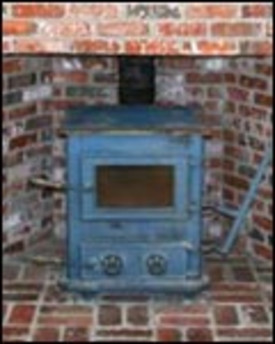Fire
 A fireplace or stove makes a house warmer, but also increases the risk of fire or carbon monoxide poisoning. Have all heat-producing systems checked annually and install smoke and carbon monoxide detectors on every level of the home. |
Fire prevention, detection, and response measures need to be at the top of your safety checklist, especially if you are a landlord. The hazards associated with smoke and flames are the most dangerous, which is why smoke detectors are mandatory in public spaces. With these devices, a sensor activates in response to heat or smoke. It then triggers an alarm, which must be loud enough to awaken residents from their sleep. In the case of the blind or hearing impaired, special alarms signal inhabitants with flashing lights, motion, or increased decibel levels.
Smoke detectors may be either battery-operated or hard-wired. If you are installing smoke detectors in an existing dwelling, installing battery-operated devices is the simplest and most economical. The biggest problem with battery-operated smoke detectors, however, is that you won’t know if they’re out of order until it’s too late! Test them once a month to make sure, and replace the batteries once a year. If you do it when you change the clocks for daylight savings, it will become a part of your safety routine.
Another option is to have the smoke detectors hard-wired as you would other electrical lamps and fixtures. Just be sure that you install a battery backup in case of electrical power outages. Hardwiring is easiest to do when you are building a new house or putting on an addition. It’s also a perfect time to look into servicing all of your home safety and security needs through one central system.
Fire Response
In addition to smoke detectors, there are several other items that will help you in the case of a fire emergency. Escape ladders can be purchased for $50-$100, depending on length, and hook to most windowsills. They should be kept in an accessible spot, near the window so that people on the second floor can move quickly to safety in case of fire. It is important to draw up an escape plan for your family. Plot out escape routes and backups, designate a meeting place away from the house, double check egress windows for size and ease of opening, and practice evacuating through windows via escape ladders.
Fire extinguishers are a must, but you must also know how to use them. The best extinguishers are labeled ABC, and are effective in fighting all types of common household fires: A for combustibles; B for flammable liquids, oils, and gases; C for electrical fires in wiring or appliances. Extinguishers should be kept on every level of the home and checked regularly for refilling or maintenance.
 |
||||
|
||||
Carbon Monoxide
Approximately 500 to 1,000 people are killed in the home each year by carbon monoxide, while nearly 5,000 people are treated in emergency rooms for CO poisoning. Carbon monoxide (CO) is a toxic gas produced during the burning of any carbon-based fuel, and presents serious health risks in homes and offices. It is colorless, odorless, and often goes undetected. The symptoms of CO poisoning can resemble the flu, which is why CO exposure is often left untreated. Higher dosages can cause impaired judgment, confusion, paralysis, coma, and death.
To protect your family from carbon monoxide exposure, all fuel-burning appliances (stoves, furnaces, water heaters, dryers, etc.) should be checked for leaks by a qualified technician. Metal flues and heat exchangers should be inspected for signs of rust or cracking, and carbon monoxide detectors should be installed in the basement, outside sleeping areas, in workrooms, and garages. Detectors may be battery powered, outlet based, or hard wired. Those meeting UL standard 2034 will detect long-term, high-level CO concentrations as well as short-term, low-level CO concentrations.
You can also purchase a combination Smoke/Fire/CO detector with voice and alarm warnings, for about $50. It is battery-operated and uses voice warnings to announce "Fire, Fire" or "Warning! Carbon Monoxide," coupled with an alarm. Safety measures such as these as inexpensive, easy to install, and a quick and easy safeguard for your health and home.
If you suspect you or someone in your home has fallen victem to Carbon Monoxide poisoning, you should immediately contact your local poison center for carbon monoxide poisoning prevention information (preferably from a phone outside the affected home). The nationwide poison hotline, 1-800-222-1222, puts callers in touch with nurses, pharmacists, and doctors at the closest poison center, 24/7.
Credit: Renovate Your World




























